The Barbet
AKC’s Latest Addition to the Sporting Group
The Canine Chronicle November/December 2019
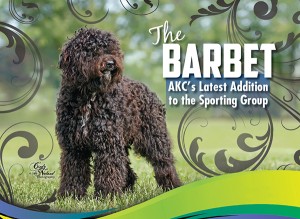 By Judy Descutner Hickory Tavern Farm
By Judy Descutner Hickory Tavern FarmThe American Kennel Club has added 27 fully recognized breeds since 2010, including the 2015 addition of both the Spanish Water Dog and Lagotto Romagnolo. The Sporting group expands again in January 2020 with the addition of their French cousin, the Barbet, an agile marsh retriever with an affable and sunny disposition. Devoted, intelligent, responsive, and joyful, the Barbet is a medium sized, curly coated dog with a distinctive beard (barbé), a whimsical appearance, and an influential history. Sharing some of the same relations as other European curly coated breeds (Portuguese Water Dog, Spanish Water Dog, Irish Water Spaniel, Lagotto Romagnolo, etc.), this French water dog’s standard was first written in 1894 for the French Société Centrale Canine. The Barbet has been recognized by the FCI for 65 years and history suggests that the Poodle, Bichon Frise, and several other breeds took their foundation from the Barbet.
Over 500 Barbet are currently registered with AKC. The majority of these dogs were born in America from a foundation of stock imported mostly from Canada, The Netherlands, France, and Poland. Barbet have spent the past three years in AKC’s Miscellaneous group where dogs have earned titles in conformation, obedience, rally, dock diving, agility, coursing ability, farm dog, scent work, trick dog, therapy, and Canine Good Citizen. The Barbet Club of America was formed in 2009 with the goal of gaining full AKC recognition, which will put the Barbet on par with its standing in Canada and FCI countries.
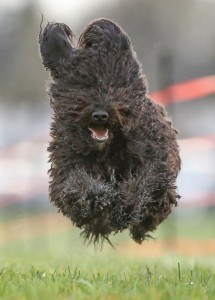
In 2012, The Wall Street Journal ran a front page article focusing on our efforts to grow the breed in the United States. Much attention was brought to the Barbet but the steady, conscientious work by breeders has produced relative consistency of type throughout North America, especially when one considers the very small population.
What is unique about the Barbet?
The head: The substantial, broad skull is fully coated with hair long enough to fall to the bridge of the nose. The square muzzle is covered in a full mustache and beard and is somewhat shorter than the backskull. Set level with the eye, the wide ears are low and lie flat against the head with ear leather reaching the corner of the mouth and the hair reaching to at least the tip of the wide nose. Teeth are large and capable of carrying a sizable bird. Expression is soft and friendly.
The outline: A profuse and tousled curly coat covers his entire body. Barbet are medium sized and slightly rectangular, with a proportionally large head atop a strong neck that flows into smooth shoulders. The front assembly is well angled with the front legs set directly underneath the withers. The topline has a slight rise over the loin yet the back appears level. A rounded croup allows for a low set tail that is happily carried above horizontal. Well bent stifles balanced with perpendicular, low set hocks provide the propulsion. Bone is moderate to substantial, contributing to the sturdy frame. Balance is key to maintaining the moderate proportions of this agile breed. Dogs stand 21-24½ inches at the wither with bitches two inches shorter at 19-22½ inches. Males generally weigh 55-60 pounds with females in the low to mid-40s. The AKC Barbet standard calls for a lower height range than the CKC or FCI standards in order to preserve the traditional medium size. Today’s population of North American Barbet nearly all fall within the AKC standard.
 The coat: Similar to the coat of the Portuguese Water Dog, Barbet hair ranges from loose wavy curls to a tight frizzy spiral. Different coats will give the impression of varying substance. In all cases, the coat should be formed into tendrils and not brushed out in an open manner. Because the coat of the Barbet constantly grows in length, trimming and scissoring are frequently needed to keep the coat from obscuring the lines of the body. It is important that the dog is shown with an appropriate, natural presentation and is not unkempt nor overdone. The hair should be easily parted to the skin, clean, and able to hold its curly texture. It should not be blown out, sculpted, corded, felted, or matted.
The coat: Similar to the coat of the Portuguese Water Dog, Barbet hair ranges from loose wavy curls to a tight frizzy spiral. Different coats will give the impression of varying substance. In all cases, the coat should be formed into tendrils and not brushed out in an open manner. Because the coat of the Barbet constantly grows in length, trimming and scissoring are frequently needed to keep the coat from obscuring the lines of the body. It is important that the dog is shown with an appropriate, natural presentation and is not unkempt nor overdone. The hair should be easily parted to the skin, clean, and able to hold its curly texture. It should not be blown out, sculpted, corded, felted, or matted.Judging the Barbet: The overall impression of a Barbet should indicate a dog who is confident, strong, fit, agile, and light-footed; beautifully presented in a natural manner. The hair on the head falls lightly over the eyes, somewhat masking the vision of the dog. For this reason, judges should approach from the front rather than the side. A thorough hands-on exam should allow the judge to discover a dog whose conformation is not complicated. The slightly rectangular shape, balanced front and rear angles, substantive head and bone, etc. are common to many breeds. The details of type are what make the Barbet different than the other curly water dogs. Maturity should bring breadth to the head and body.

On the move, the Barbet should convey forward motion with a bit of upright carriage; the AKC standard uses the word “smart” and this is achieved by a personable dog who is going somewhere, not a flat or hollow slouch being drug around the ring. Side gait is moderate with precise foot timing. Coming and going, the legs should converge on the centerline. The long tail should be elevated in motion without curling onto the back and the dog should be handled lightly on a loose lead. A hint of clownish behavior is common as the Barbet has a genuine joie de vivre.
What should judges reward? A few breeder perspectives:
Anne Plomp, Nuphars: A good Barbet’s silhouette is different from the other water dogs. The slightly longer than tall proportions in the body, with a normal 50/50 proportioned length of leg already sets it apart from the Lagotto, Spanish Water Dog, and Portuguese Water Dog. The shape of the head, the flow of neck into shoulder, strong compact loin, slightly rounded croup, long second thigh and low hock complete the picture. The shape of the hindquarters especially defines the outline. Judges should reward the short, strong muzzle, correct length of legs, well placed fronts, good bone, well shaped ribs of correct depth, strong loins, and proper rear. A correctly proportioned and constructed Barbet is a fairly ‘boring’ dog as it does not have flashy movement with overdone reach and drive, but it should impress with efficient, easy movement.
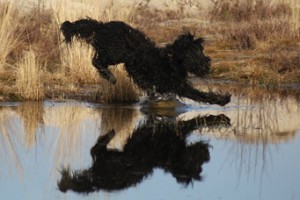
Stacy Able, Ginkgo: Judges should keep in mind the breed’s purpose as a marsh retriever and reward a strong head, square muzzle, good muscle tone and bone, a strong neck to carry a bird out of a marsh, and texture in the coat to protect the body.
Stephanie Dixon, Northrock: The well developed chest and rounded ribs are important in order to accommodate the lungs and heart needed to function as a working retriever. Barbet are presented in the ring with a long, thick coat that is neat in appearance. The coat should retain its natural curl. Their distinctive beard is a quintessential characteristic of the breed. Although the ability to assess the quality of the coat is imperative, more importance should be given to breed type, structure, balanced easy movement with moderate reach and drive, and the correct, joyful temperament of the breed. A Barbet is preferably shown on a loose lead with the opportunity to evaluate a free stack to see how the dog lands naturally.
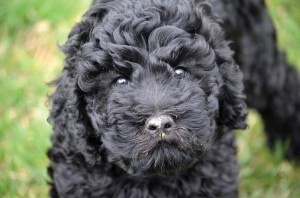 Leslie Woodward, Anam Chara: Judges should reward an impeccably turned out, yet gently trimmed exhibit who is in excellent condition with a long coat in natural curls. Barbet must be going somewhere on the move – forward, effortlessly. The gait is, most importantly, precise in cadence.
Leslie Woodward, Anam Chara: Judges should reward an impeccably turned out, yet gently trimmed exhibit who is in excellent condition with a long coat in natural curls. Barbet must be going somewhere on the move – forward, effortlessly. The gait is, most importantly, precise in cadence.For further education, AKC offers a course on the Barbet in their Canine College that was produced in conjunction with the parent club. The Barbet Club of America also offers Judges Education. Differences in type and presentation may be seen as the Barbet enters wider AKC competition. The standard allows for variance in coat, curl, and color yet the Barbet’s unique outline should be immediately recognizable. With a January debut in the Sporting group, the Barbet takes his well-deserved place among other working retrievers who are outstanding companions.
General Appearance: An archetypic water dog of France, the Barbet is a rustic breed of medium size and balanced proportions which appears in works as early as the 16th century. In profile, the Barbet is slightly rectangular with a substantial head and long, sweeping tail. He has a long, dense covering of curly hair and a distinctive beard (French barbé), which gives the breed its name. An agile athlete, the Barbet has been used primarily to locate, flush, and retrieve birds. He has a cheerful disposition; very social and loyal.
Size, Proportion, Substance: Height at the withers: Dogs 21–24.5 inches, Bitches 19–22.5 inches. Weight in proportion to height. Proportions: Measured from point of shoulder to buttocks and withers to ground, the Barbet is slightly longer than tall. Exact proportion is not as important as balance. Substance: Neither coarse nor refined, the Barbet is solidly built with adequate bone to perform his tasks as a true sporting dog.
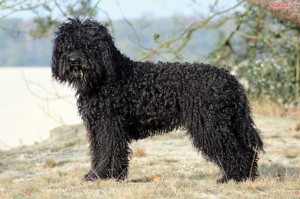 Head: Of great importance, the head is strong, broad, and proportionally large. Expression is bright, engaging. Eyes of medium size, nearly round in shape, dark hazel to dark brown, harmonizing with the coat color. Eye rims are fully pigmented, corresponding to coat (black for black, black pied or gray dogs; brown for brown or brown pied dogs. Fawn dogs may have either black or brown pigmentation). Ears are wide and are set at eye level. Ear leather reaching at least to the corner of the mouth and fully covered with long hair. Skull is rounded and broad. Occiput is not prominent. Stop is defined, neither abrupt nor sloping. Head planes are nearly parallel. The muzzle is shorter than the skull and is quite square. Bridge of nose is broad. Lower jaw fairly square and strong. Jaws of equal length. The nose is large, with well opened nostrils, fully pigmented in harmony with coat color. Lips are thick, fully pigmented. Flews are tight. Scissors bite, teeth large and strong.
Head: Of great importance, the head is strong, broad, and proportionally large. Expression is bright, engaging. Eyes of medium size, nearly round in shape, dark hazel to dark brown, harmonizing with the coat color. Eye rims are fully pigmented, corresponding to coat (black for black, black pied or gray dogs; brown for brown or brown pied dogs. Fawn dogs may have either black or brown pigmentation). Ears are wide and are set at eye level. Ear leather reaching at least to the corner of the mouth and fully covered with long hair. Skull is rounded and broad. Occiput is not prominent. Stop is defined, neither abrupt nor sloping. Head planes are nearly parallel. The muzzle is shorter than the skull and is quite square. Bridge of nose is broad. Lower jaw fairly square and strong. Jaws of equal length. The nose is large, with well opened nostrils, fully pigmented in harmony with coat color. Lips are thick, fully pigmented. Flews are tight. Scissors bite, teeth large and strong.
Neck, Topline and Body: Neck is strong, blending well into the body. Back is solid with well sustained level topline, loin is short and slightly arched, croup rounded. The tail is the natural extension of the topline, long and low set. When in motion the tail is carried above horizontal in a sweeping curve but does not curl onto the back. The tail is never docked. Body is athletic with substance, chest is broad, well-developed, deep, reaching the elbow; ribs rounded but not barrel-like, underline slightly inclined without tuck-up.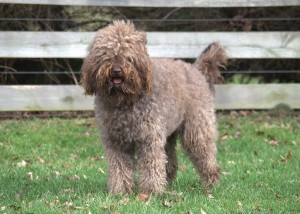
Forequarters: Emphasis is on balance. Shoulders are well laid back and approximately the same length as the upper arm, placing the front legs well under the chest with elbows close to the body. Legs are straight and strong; well boned. Pasterns are strong and flexible. Front dewclaws may be removed. Feet are round, and toes are tight, well-arched. Pads thick.
Hindquarters: Angulation balances with forequarters. Up-per thigh is well muscled, stifle well bent, second thigh is well developed, hocks well let-down, short and perpendicular to ground; without dewclaws. Feet same as front.
Coat: The coat of the Barbet is his defining characteristic. Profuse hair covers the whole body evenly with thick, natural curls that range from large and loose to tight, smaller curls. The hair on the top of the head reaches the bridge of the nose. He has a distinctive beard. Ears are covered in long hair. The coat is shown in as natural a state as possible; clean and free from mats. The hair is to retain curl. While scissoring is necessary to keep him neat, excessive sculpting and shaping is to be penalized.
Color: All shades of black, gray, brown, fawn; with or without white markings. Pied (primarily white with all shades of black, gray, brown, fawn markings).
Gait: Easy, ground-covering trot with good front reach and impulsion from hindquarters with precise cadence. Feet converge toward the centerline with increased speed. Topline remains level and carriage is smart.
Temperament: The Barbet is a responsive, loving member of the family. Joyful, bright, and kindly natured, he is a versatile sporting dog and willing participant in many activities. The sensitive Barbet responds to positive interaction and training, and displays an even temperament.
Size, Proportion, Substance: Height at the withers: Dogs 21–24.5 inches, Bitches 19–22.5 inches. Weight in proportion to height. Proportions: Measured from point of shoulder to buttocks and withers to ground, the Barbet is slightly longer than tall. Exact proportion is not as important as balance. Substance: Neither coarse nor refined, the Barbet is solidly built with adequate bone to perform his tasks as a true sporting dog.
 Head: Of great importance, the head is strong, broad, and proportionally large. Expression is bright, engaging. Eyes of medium size, nearly round in shape, dark hazel to dark brown, harmonizing with the coat color. Eye rims are fully pigmented, corresponding to coat (black for black, black pied or gray dogs; brown for brown or brown pied dogs. Fawn dogs may have either black or brown pigmentation). Ears are wide and are set at eye level. Ear leather reaching at least to the corner of the mouth and fully covered with long hair. Skull is rounded and broad. Occiput is not prominent. Stop is defined, neither abrupt nor sloping. Head planes are nearly parallel. The muzzle is shorter than the skull and is quite square. Bridge of nose is broad. Lower jaw fairly square and strong. Jaws of equal length. The nose is large, with well opened nostrils, fully pigmented in harmony with coat color. Lips are thick, fully pigmented. Flews are tight. Scissors bite, teeth large and strong.
Head: Of great importance, the head is strong, broad, and proportionally large. Expression is bright, engaging. Eyes of medium size, nearly round in shape, dark hazel to dark brown, harmonizing with the coat color. Eye rims are fully pigmented, corresponding to coat (black for black, black pied or gray dogs; brown for brown or brown pied dogs. Fawn dogs may have either black or brown pigmentation). Ears are wide and are set at eye level. Ear leather reaching at least to the corner of the mouth and fully covered with long hair. Skull is rounded and broad. Occiput is not prominent. Stop is defined, neither abrupt nor sloping. Head planes are nearly parallel. The muzzle is shorter than the skull and is quite square. Bridge of nose is broad. Lower jaw fairly square and strong. Jaws of equal length. The nose is large, with well opened nostrils, fully pigmented in harmony with coat color. Lips are thick, fully pigmented. Flews are tight. Scissors bite, teeth large and strong.Neck, Topline and Body: Neck is strong, blending well into the body. Back is solid with well sustained level topline, loin is short and slightly arched, croup rounded. The tail is the natural extension of the topline, long and low set. When in motion the tail is carried above horizontal in a sweeping curve but does not curl onto the back. The tail is never docked. Body is athletic with substance, chest is broad, well-developed, deep, reaching the elbow; ribs rounded but not barrel-like, underline slightly inclined without tuck-up.

Forequarters: Emphasis is on balance. Shoulders are well laid back and approximately the same length as the upper arm, placing the front legs well under the chest with elbows close to the body. Legs are straight and strong; well boned. Pasterns are strong and flexible. Front dewclaws may be removed. Feet are round, and toes are tight, well-arched. Pads thick.
Hindquarters: Angulation balances with forequarters. Up-per thigh is well muscled, stifle well bent, second thigh is well developed, hocks well let-down, short and perpendicular to ground; without dewclaws. Feet same as front.
Coat: The coat of the Barbet is his defining characteristic. Profuse hair covers the whole body evenly with thick, natural curls that range from large and loose to tight, smaller curls. The hair on the top of the head reaches the bridge of the nose. He has a distinctive beard. Ears are covered in long hair. The coat is shown in as natural a state as possible; clean and free from mats. The hair is to retain curl. While scissoring is necessary to keep him neat, excessive sculpting and shaping is to be penalized.
Color: All shades of black, gray, brown, fawn; with or without white markings. Pied (primarily white with all shades of black, gray, brown, fawn markings).
Gait: Easy, ground-covering trot with good front reach and impulsion from hindquarters with precise cadence. Feet converge toward the centerline with increased speed. Topline remains level and carriage is smart.
Temperament: The Barbet is a responsive, loving member of the family. Joyful, bright, and kindly natured, he is a versatile sporting dog and willing participant in many activities. The sensitive Barbet responds to positive interaction and training, and displays an even temperament.
About the Author
As a breeder, exhibitor, and long time board member of the Barbet Club of America, Judy was instrumental in promoting the Barbet in the United States. Also involved with Whippets since 1985, Judy lives at Hickory Tavern Farm and is the new delegate for the Western Pennsylvania Kennel Association.

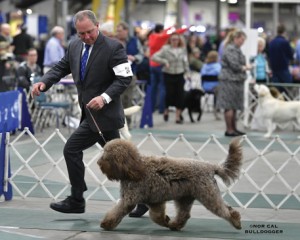
No comments:
Post a Comment